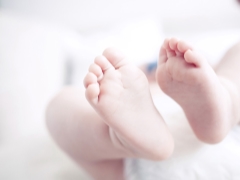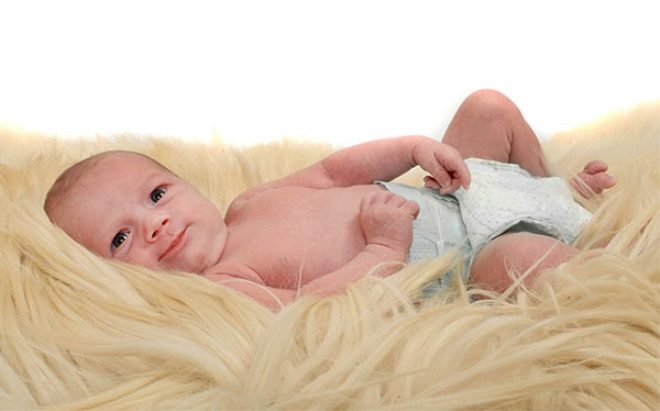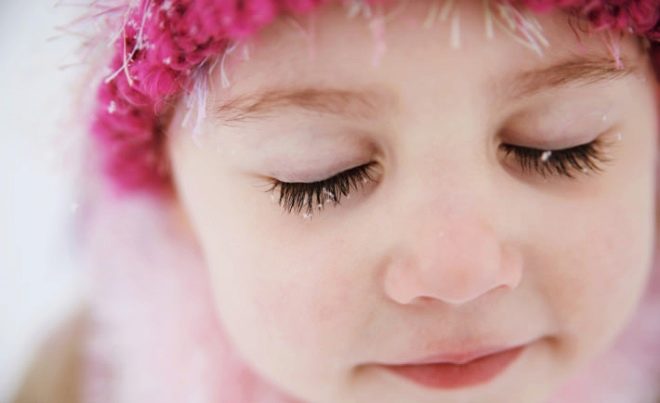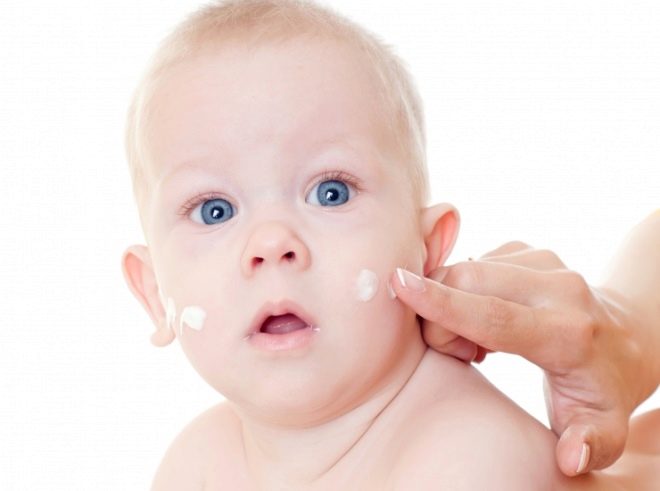Dry skin of the hands and feet of a child
Moisture of the skin in babies is different. Tendency to dry skin can be present even in a healthy baby. This article will help parents understand what is the norm and pathology.
How does it manifest itself?
Dry skin in its density is markedly different from moist. This difference is usually revealed by parents when carrying out the baby’s hygienic toilet every day. In some cases, the skin becomes more rough and uneven to the touch.
Severe dryness can lead to the appearance of small cracks on the skin, which become possible “gates” for the penetration of secondary infection.
The color of dry skin is noticeably different from healthy. Usually they look brighter, the skin relief may be disturbed.
The density of the affected areas is reduced. The skin becomes less smooth, shiny. With some forms of allergic eczema, it looks "aged."
The localization of the appearance of dry areas depends largely on the underlying cause, which contributed to their development. If severe dryness appears between the fingers, then often this indicates the development of scabies in the child.
Dry fingertips are often a symptom of vitamin deficiencies or allergies. After suffering viral or bacterial infections, in some cases, dry skin may also increase.
If, for an unknown reason, your palms have become dry and the skin itchiness has increased, then you should pay attention to the way you wash your hands with soap.
The reasons
According to statistics, dry skin of the hands and feet is most common in newborn babies and children of the first year of life.
Many parents prefer to cope with this condition at home, without seeking medical help. Others believe that it is impossible to cope independently with increased dryness
In order to figure out in which case specialist consultation may be required, you must first understand what doctors consider healthy skin.
The skin of the baby is usually smooth to the touch. Optimal skin hydration is provided by complex metabolic processes. The condition of the skin depends largely on how well the child has a water-lipid layer. A special ratio of hydrophilic molecules and lipid fractions ensures proper hydration of the skin layers.
A variety of causes lead to the development of excessive dryness in a baby. The baby’s tender skin is very sensitive to the effects of numerous environmental factors. These adverse causative factors include:
Strong temperature fluctuations
Hypothermia or overheating of the skin leads to a violation of the water-lipid layer, which is manifested in the child the development of severe dryness.
Walks and games outside in windy weather without gloves and mittens lead to the fact that on the fingers of the baby appear various dry areas. Quite often, they are very shelled.
Decrease in humidity indoors
Normally, the humidity indicator in the room should be from 50 to 60%. Too dry air provokes in the child the appearance of sufficiently dry areas on the skin, which in some cases may itch a little.
Combing the skin can contribute to the introduction of a secondary bacterial infection, which causes infectious skin diseases in the future.
Long stay in hot water
Quite often, this situation occurs with babies-babies. The presence of a child in hot water contributes to the violation of the water-lipid layer of the skin, resulting in dryness on the legs of the infant.
Also, this symptom often appears on the toes.
Chronic diseases of internal organs
Reduced thyroid function or hypothyroidism is quite common in babies. One of the clinical signs of this condition is the appearance of dry areas on the skin.
Irritable bowel syndrome and dysbiosis also lead to impaired metabolic processes that occur in the skin.
Incorrect nutrition
Insufficient content of trace elements in the daily diet of children contributes to metabolic disorders. Quite often, a deficiency of vitamins A, E and B causes the child to develop severe dryness of the skin.
In infants, the appearance of a dry speck on the skin is caused by an improperly adapted artificial feeding formula.
Allergic diseases
Allergies, especially during periods of exacerbations, many types of dermatitis and eczema occur with the appearance of severe dryness of the skin. In some pathologies, the affected areas are quite large in area.
Often, allergic skin manifestations are accompanied by the appearance of pronounced itching, which brings the child severe discomfort and worsens his health.
Helminthic invasions
In the course of their vital activity, helminths (worms) secrete a large number of various biologically active substances that have a toxic effect on the skin.
Persistent helminthiasis, as a rule, is accompanied by the development of severe dryness of the skin in a child and the appearance of various skin rashes on it.
Hormonal imbalance
Quite often occurs in adolescence and puberty. A surge of hormones with a systemic effect has multiple effects, including on the skin.
Usually this situation contributes to the change in the structure of the skin. It usually becomes more dry and prone to the development of rashes.
Improperly selected children's cosmetics
Quite often, excessive use of body lotions containing alcohol or active chemical components leads to the development of dry skin in children.
Prolonged use of these products contributes to the fact that the delicate children's skin dries strongly and various rashes appear on it more often.
The use of tar or household soap for washing young toddlers can also cause severe dryness in a child.
Violation of the drinking regime.
To compensate for the loss of fluid, which is physiologically excreted from the body with sweat, urine, saliva and feces, a mandatory replenishment of water is required.
The decrease in fluid intake per day contributes to the fact that the baby appears pronounced violations of moisture and skin turgor.
This is especially noticeable during hot weather and after active sports.
Scabies
This disease, caused by a scabies mite, is quite often recorded in babies. In the high-risk group children attending educational institutions.
Doctors say that scabies is most often found in crowded teams. The disease manifests itself, as a rule, the occurrence of dry skin between the fingers, which are very peeling.
Diagnostics
Children's dermatologist will help to distinguish pathology from the norm. A visit to this specialist is required.
In some cases, a mask of increased dryness of the skin hides dangerous diseases, which are detected later only in the later stages. Timely seeking medical advice will help to avoid negative consequences and prevent the development of adverse pathologies.
Initially, it is necessary to establish the cause that led to the development of dryness in the child. If it is not eliminated, the subsequent symptomatic treatment will have only a temporary unstable result.
In some cases, to establish the cause of this condition, a whole complex of diagnostic measures is required. The baby is subjected to general clinical blood and urine tests, biochemical tests, and ultrasound of the internal organs. Such an extended diagnosis allows you to specify the cause that caused the occurrence of adverse symptoms in a child.
Treatment
After carrying out a complex of diagnostics, doctors make recommendations. Usually they include the following principles:
Proper nutrition
The daily diet of the baby must necessarily contain healthy unsaturated fats. Inclusion in the children's menu of dishes prepared from red fish and containing vegetable oils will have an excellent effect on the skin.
To compensate for the deficiency of vitamins, it is necessary to include a variety of fruits and vegetables in the diet of the baby.
Use of moisturizing baby cosmetics
Currently, there is a huge amount of a wide variety of cosmetic products. Regular use helps to improve the water-lipid layer of the skin and improve its appearance.
As a cosmetic products should be used approved and specially designed for children.
They should not contain any aggressive chemical components that contribute to allergic reactions on the skin or increase dryness.
Monitor the time spent in the water
Do not overdry the skin during hygiene procedures. Very often this happens while bathing a child.
The duration of water procedures is strictly regulated taking into account the age of the baby. Sitting in hot water for longer than the prescribed period contributes to the appearance of dryness, and further irritation of the skin.
Adding decoctions in baths
With the tendency of the baby to the appearance of irritation on the skin, you can add broths made from herbs to the bath. For this perfect chamomile, calendula, sage.
The use of these funds is also an excellent prevention of infectious secondary lesions on the skin.
Learn about skin care in newborns from the following video.

























